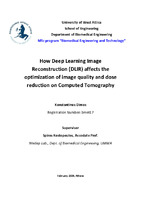| dc.contributor.advisor | Kostopoulos, Spiros | |
| dc.contributor.author | Δήμος, Κωνσταντίνος | |
| dc.date.accessioned | 2024-03-19T09:00:08Z | |
| dc.date.available | 2024-03-19T09:00:08Z | |
| dc.date.issued | 2024-02-29 | |
| dc.identifier.uri | https://polynoe.lib.uniwa.gr/xmlui/handle/11400/6110 | |
| dc.identifier.uri | http://dx.doi.org/10.26265/polynoe-5946 | |
| dc.description.abstract | The aim of this study is to investigate the influence of deep learning-based
reconstruction (DLIR) on image quality across varying dose levels within a Chest-
Abdomen-Pelvis (CAP) protocol using a 512-slice CT scanner and an advanced
anthropomorphic phantom. Comparative analysis between DLIR, Adaptive
Statistical Iterative Reconstruction (ASIR-V), and conventional Filtered
BackProjection (FBP) reconstructions was conducted at normal, low, and ultra-low
dose levels.
The CT scanner employed in this experiment is the Revolution APEX by GE
HealthCare (Waukesha, WI, USA). The experiment involves the use of a dedicated CT
whole-body phantom, the PBU-60 by Kyoto Kagaku. A quantitative analysis was
conducted, comparing the FBP Normal Dose (ND) and various reconstruction
algorithms across three distinct dose levels (normal, low and ultra-low dose) and
chest/abdomen/pelvis regions. Furthermore, an additional quantitative assessment
was included, using ASIR-V60% as a reference due to its widespread utilization,
between ASIR-V90% and DLIR-H. Also, a qualitative analysis performed to evaluate
the general image quality and overall contrast of ASIR-V60%, ASIR-V90% and DLIR-H.
The evaluation was carried out in terms of Signal-to-Noise Ratio (SNR) and Contrastto-
Noise Ratio (CNR).
The results highlight the feasibility of a low-dose protocol and suggest the potential
introduction of an experimental ultra-low-dose protocol for CAP. The proposed
implementation relies on the use of a deep-learning-based image reconstruction
algorithm, which aims to maintain image quality and contrast levels comparable to
those typically observed with conventional reconstruction algorithms used in regular
and low-dose protocols. | el |
| dc.format.extent | 51 | el |
| dc.language.iso | en | el |
| dc.publisher | Πανεπιστήμιο Δυτικής Αττικής | el |
| dc.rights | Αναφορά Δημιουργού - Μη Εμπορική Χρήση - Παρόμοια Διανομή 4.0 Διεθνές | * |
| dc.rights.uri | https://creativecommons.org/licenses/by-nc-sa/4.0/deed.el | * |
| dc.subject | Iimage quality | el |
| dc.subject | Ultra-low dose | el |
| dc.subject | Deep learning image reconstruction | el |
| dc.subject | Anthropomorphic phantom | el |
| dc.title | How Deep Learning Image Reconstruction (DLIR) affects the optimization of image quality and dose reduction on Computed Tomography | el |
| dc.title.alternative | Πώς o αλγόριθμος ανακατασκευής εικόνας βαθιάς μάθησης (DLIR) επηρεάζει την τη βελτιστοποίηση της ποιότητας της εικόνας και τη μείωση της δόσης ακτινοβολίας στην υπολογιστική τομογραφία | el |
| dc.type | Μεταπτυχιακή διπλωματική εργασία | el |
| dc.contributor.committee | Glotsos, Dimitris | |
| dc.contributor.committee | Λιαπαρίνος, Παναγιώτης | |
| dc.contributor.faculty | Σχολή Μηχανικών | el |
| dc.contributor.department | Τμήμα Μηχανικών Βιοϊατρικής | el |
| dc.contributor.master | Biomedical Engineering & Technology | el |


